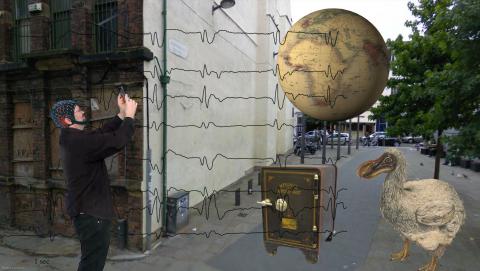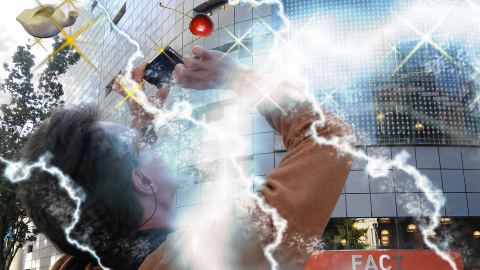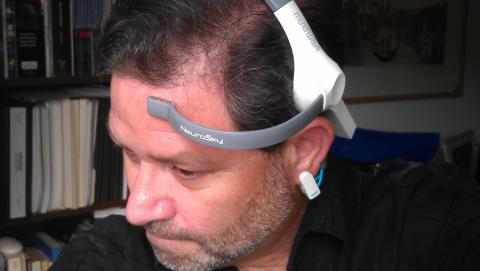EEG AR: Things We Have Lost
“EEG AR: Things We Have Lost,” will allow participants to conjure up virtual objects by simply imagining them into existence using brainwave sensor technology. We will generate a database of objects based on the broad theme of “Things We Have Lost,” which includes things such as pensions, empires and dodo birds. We will outfit test subjects with EEG-reading brainwave sensors and ask them to think deeply about what he or she has lost. Once our software detects a measurable and consistent pattern, it will issue a database call to instantiate a virtual object using augmented reality technology. The virtual object will then appear in front of the participant, viewable on any iPhone or Android device. As part of the exhibition, we will take the test subjects into the city to see if it is possible to create and place virtual objects just by thinking them into existence. These virtual objects will remain at the location as trace reminders of the lab experience.

As part of the research, development and community engagement of this project, we are working with FACT’s videography team Carl Davies and Mike Donaghy to ask the people of

We are generating a series of Vox Pop style video clip where people are selected at random in the streets of Liverpool and simply asked, “What have you lost?” The location, where the footage was shot, is recorded. We are then creating a database of virtual lost objects based on the responses given. The virtual lost object is then placed back in the exact GPS coordinates where the recording was made, creating a citywide network of lost things which can only be seen through a any late model iPhone, iPad or Android device.

During scheduled lab/clinical hours, we will invite the public to participate by appointment or on a first-come-first-serve, walk-in basis. During the times that the *doctors/scientist/artists are not able to be present physically at the clinic, we will conduct trials remotely using telecommunication and monitoring technologies. As audience members enter the EEG AR: lab/clinic, they will be greeted by one of the artists or an assistant, who will screen them at the reception desk to pre-qualify them as test subjects. While we prepare the exam room for the trial, subjects who meet the criteria will wait in the waiting room, which resembles a tea lounge or doctor’s office, where they can enjoy video documentation of past trial results on a flat screen television. Individual test subjects will be invited back to the exam area and asked to take a seat in a reclining exam chair, which is situated in front of a large live feed projection. We will.

The test subject will be asked to relax and to think deeply about what he or she has lost. We will begin by measuring the Attention and Meditation values represented by the medium and

If those values meet or exceed a predetermined high value, an SQL statement will be generated which will query the database of lost things and randomly select one to instantiate in the physical location, where anyone can view it using a smart phone. The experience can take up to thirty minutes per test subject to complete and must run its course. Once we get this functionality working we intend to explore pairing the brainwave sensor to the test subjects smart phone, so that the experiment can be move out of the lab environment and into the streets of Liverpool. This project is being developed in collaboration with ManifestAR, an international artists’ collective working with emergent forms of augmented reality as interventionist public art. The group was recently awarded the ARtSENSE Commission at FACT, in Liverpool. FACT (Foundation for Art and Creative Technology) has been leading the UK video, film and new media arts scene for 20 years with groundbreaking exhibitions, education and research projects. The organization aims to pioneer new forms of artistic and social interaction with individuals and communities. ARtSENSE is a European research project in collaboration with 2 other cultural organizations and 5 technical and research organizations to develop wearable technology that aims to improve and augment the gallery and museum visitor experience. The technology will be discreetly embedded into eye glasses, with information beamed directly onto the retina of the wearer. The planned research will look at monitoring the physiological activity of the user, included eye-tracking, heart rate and skin conductivity to ascertain the “state” of the user (bored, excited, interested) and to then adapt the information sent to the user (textual, audio, video) accordingly. This commission was awarded in order to create significant new artworks that align with one of its current research interests looking at augmented visitor experience. Our project will explore linking augmented virtual objects with audience response translated through compact wearable bio, audio, eye and brainwave sensing devices. We will create individual and collective works based on the theme; I think, I see, I speak, I feel- therefore it is. Our research will involve a year-long collaboration between ManifestAR artists, FACT and the ARtSENSE Consortium. The project will culminate in an exhibition at FACT in 2013. ManifestAR will also explore and create work in the city of Liverpool, beyond the galleries at FACT. The exhibition “Inside Out,” including “EEG AR: Things We Have Lost.” will take place at FACT in Liverpool June 13 – August 25, 2013.
